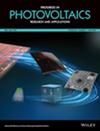Failure Analysis of Polarization-Type Potential-Induced Degradation of Perovskite Solar Cells
Abstract
Potential-induced degradation (PID) presents a significant challenge to the long-term reliability of perovskite solar cells (PSCs) in commercial applications. Research on PID in PSCs is still in its early stages, and the polarization-type PID (PID-p) remains poorly understood. In this study, we used advanced microscopic techniques to investigate the underlying mechanisms of PID-p in PSCs. After 100 h of PID stress, the devices experienced severe performance loss, with efficiency reduced to 20.9% of its initial value. This degradation was primarily driven by a decrease in short-circuit current and fill factor, while the open-circuit voltage remained relatively stable. Our findings reveal that the accumulation of sodium ions at the glass/film interface triggers the formation of an electron inversion layer at the perovskite's bottom, leading to performance decline. Electrical and mechanical characterizations further confirm changes in material properties, particularly at the hole transport layer/perovskite interface, contributing to the degradation.

 求助内容:
求助内容: 应助结果提醒方式:
应助结果提醒方式:


